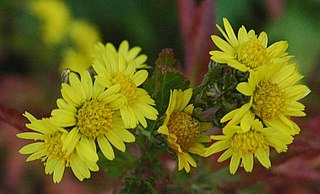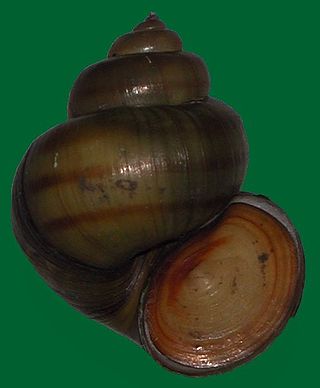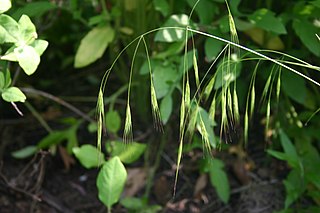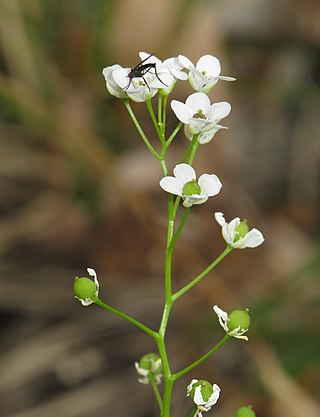
Chrysanthemums, sometimes called mums or chrysanths, are flowering plants in the Asteraceae family. They are native to East Asia and northeastern Europe. Most species originate from East Asia, and the center of diversity is in China. Countless horticultural varieties and cultivars exist.

Leucanthemum is a genus of flowering plants in the aster family, Asteraceae. It is mainly distributed in southern and central Europe. Some species are known on other continents as introduced species, and some are cultivated as ornamental plants. The name Leucanthemum derives from the Greek words λευκός – leukos ("white") and ἄνθεμον – anthemon ("flower"). Common names for Leucanthemum species usually include the name daisy, but "daisy" can also refer to numerous other genera in the Asteraceae family.

Deschampsia is a genus of plants in the grass family Poaceae, commonly known as hair grass or tussock grass. The genus is widespread across many countries.

Glebionis coronaria, formerly called Chrysanthemum coronarium, is a species of flowering plant in the family Asteraceae. It is native to the Mediterranean region. It is cultivated and naturalized in East Asia and in scattered locations in North America.

Jacobaea is a genus of flowering plants in the tribe Senecioneae and the family Asteraceae. Its members used to be placed in the genus Senecio, but have been separated into the segregate genus Jacobaea on the basis of molecular phylogenetics in order to maintain genera that are monophyletic.

Viviparus, commonly known as the river snails, is a genus of large, freshwater snails with an operculum, aquatic gastropod molluscs.

Anthyllis vulneraria, the common kidneyvetch, kidney vetch or woundwort is a medicinal plant native to Europe. The name vulneraria means "wound healer".

Elymus is a genus of perennial plants with approximately 150 species in the grass family, related to rye, wheat, and other widely grown cereal grains.

Aleksander Zawadzki born Józef Antoni Zawadzki was a Polish naturalist, author of flora and fauna lists of the Galicia region and the neighbourhood of Lviv. He was also the first scientist who studied and catalogued the beetles and butterflies of Eastern Galicia. He was responsible for encouraging Gregor Mendel to study genetics at Brno.
Psychrogeton is a genus of plants in the tribe Astereae within the family Asteraceae.

Schizachne is a genus of Eurasian and North American plants in the grass family. The only accepted species is Schizachne purpurascens, commonly called false melic. Three subspecies are recognized:

Ixeridium is a genus of Asian flowering plants in the family Asteraceae.

Leucanthemella is a genus of flowering plants in the sunflower/daisy family Asteraceae.

Chrysanthemum lavandulifolium is a flowering plant within the family Asteraceae and the genus Chrysanthemum. It is a perennial flowering plant that is often noted because of its yellow flowers. It has 18 chromosomes at the diploid stage.

Rhaponticoides is a genus of flowering plants in the family Asteraceae, found in northern Africa, southern and eastern Europe, and western Asia as far east as Mongolia. They were resurrected from Centaurea.

Leucanthemella serotina, called the autumn ox-eye, is a species of flowering plant in the genus Leucanthemella, native to Poland, Czechia, Slovakia, Hungary, Serbia, Croatia, Slovenia, Montenegro, Bosnia and Herzegovina, Macedonia, Romania, Bulgaria, and Ukraine, and introduced to Connecticut, Massachusetts, Michigan, Minnesota and New York in the United States, Ontario and Québec in Canada, and France, Germany, Great Britain, and Switzerland. It is a vigorous, erect perennial growing to 1.5 m (5 ft) tall, bearing flowerheads with white ray florets and greenish-yellow centres, throughout autumn. It has gained the Royal Horticultural Society's Award of Garden Merit, and is also considered by them to be a good plant to attract pollinators.

Anthemis cupaniana, called the Sicilian chamomile, is a species of flowering plant in the genus Anthemis, native to Sicily, and introduced to France, Great Britain, Ireland, and the Chatham Islands. It may have gained the Royal Horticultural Society's Award of Garden Merit as Anthemis punctata subsp. cupaniana.
Tanacetopsis is a genus of flowering plants belonging to the family Asteraceae.

Kernera is a monotypic genus of flowering plants belonging to the family Brassicaceae. It only contains one species, 'Kernera saxatilis'(L.) Sweet

Chrysanthemum oreastrum is a flowering plant within the family Asteraceae and the genus Chrysanthemum. It is a perennial flowering plant.



















